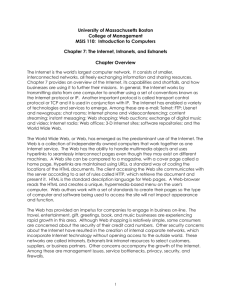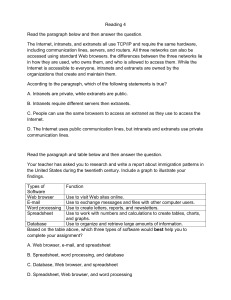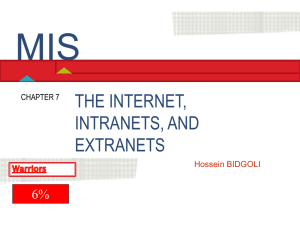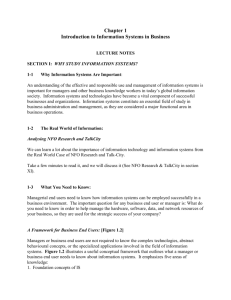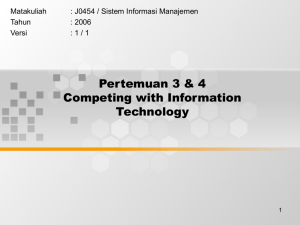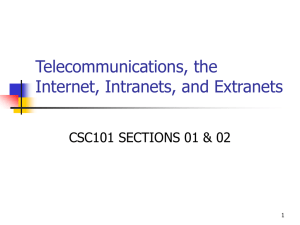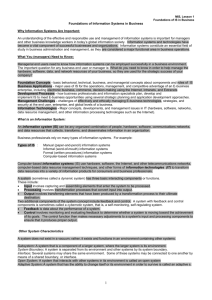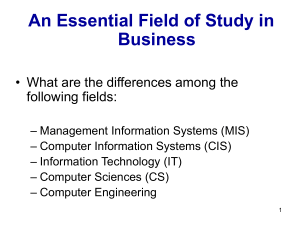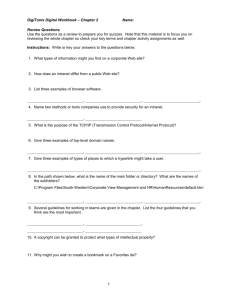The Internet, Intranets, and Extranets in Business
advertisement
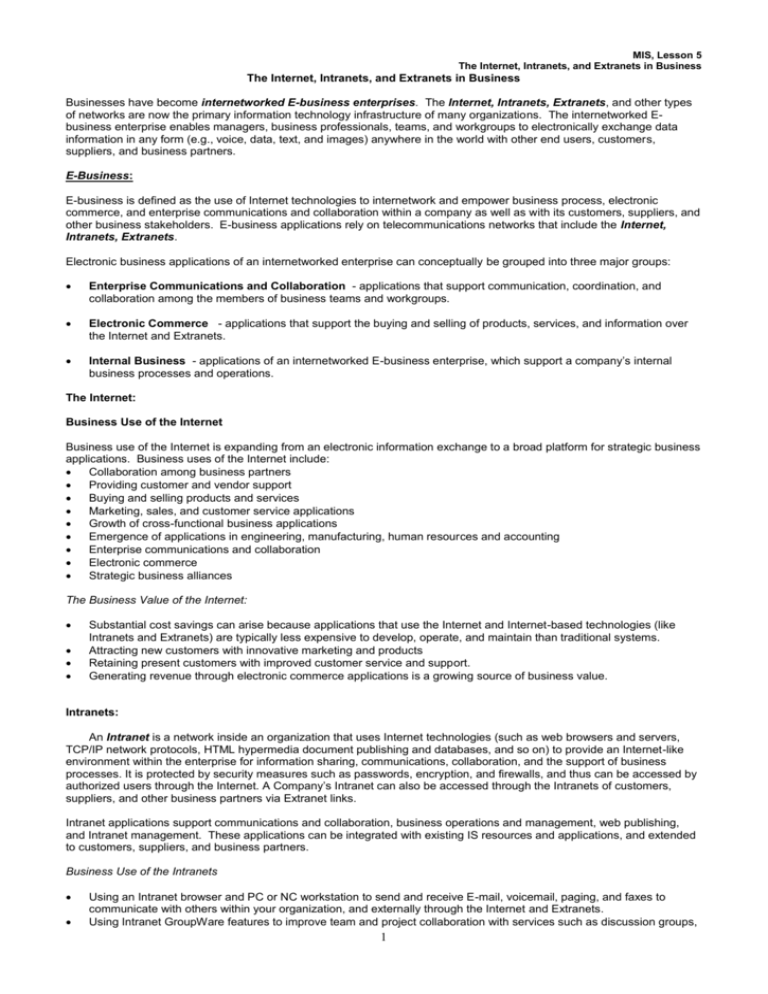
MIS, Lesson 5 The Internet, Intranets, and Extranets in Business The Internet, Intranets, and Extranets in Business Businesses have become internetworked E-business enterprises. The Internet, Intranets, Extranets, and other types of networks are now the primary information technology infrastructure of many organizations. The internetworked Ebusiness enterprise enables managers, business professionals, teams, and workgroups to electronically exchange data information in any form (e.g., voice, data, text, and images) anywhere in the world with other end users, customers, suppliers, and business partners. E-Business: E-business is defined as the use of Internet technologies to internetwork and empower business process, electronic commerce, and enterprise communications and collaboration within a company as well as with its customers, suppliers, and other business stakeholders. E-business applications rely on telecommunications networks that include the Internet, Intranets, Extranets. Electronic business applications of an internetworked enterprise can conceptually be grouped into three major groups: Enterprise Communications and Collaboration - applications that support communication, coordination, and collaboration among the members of business teams and workgroups. Electronic Commerce - applications that support the buying and selling of products, services, and information over the Internet and Extranets. Internal Business - applications of an internetworked E-business enterprise, which support a company’s internal business processes and operations. The Internet: Business Use of the Internet Business use of the Internet is expanding from an electronic information exchange to a broad platform for strategic business applications. Business uses of the Internet include: Collaboration among business partners Providing customer and vendor support Buying and selling products and services Marketing, sales, and customer service applications Growth of cross-functional business applications Emergence of applications in engineering, manufacturing, human resources and accounting Enterprise communications and collaboration Electronic commerce Strategic business alliances The Business Value of the Internet: Substantial cost savings can arise because applications that use the Internet and Internet-based technologies (like Intranets and Extranets) are typically less expensive to develop, operate, and maintain than traditional systems. Attracting new customers with innovative marketing and products Retaining present customers with improved customer service and support. Generating revenue through electronic commerce applications is a growing source of business value. Intranets: An Intranet is a network inside an organization that uses Internet technologies (such as web browsers and servers, TCP/IP network protocols, HTML hypermedia document publishing and databases, and so on) to provide an Internet-like environment within the enterprise for information sharing, communications, collaboration, and the support of business processes. It is protected by security measures such as passwords, encryption, and firewalls, and thus can be accessed by authorized users through the Internet. A Company’s Intranet can also be accessed through the Intranets of customers, suppliers, and other business partners via Extranet links. Intranet applications support communications and collaboration, business operations and management, web publishing, and Intranet management. These applications can be integrated with existing IS resources and applications, and extended to customers, suppliers, and business partners. Business Use of the Intranets Using an Intranet browser and PC or NC workstation to send and receive E-mail, voicemail, paging, and faxes to communicate with others within your organization, and externally through the Internet and Extranets. Using Intranet GroupWare features to improve team and project collaboration with services such as discussion groups, 1 MIS, Lesson 5 The Internet, Intranets, and Extranets in Business chat rooms, and audio and videoconferencing. Company newsletters, technical drawings, and product catalogs can be published in a variety of ways including hypermedia and web pages, E-mail, net broadcasting, and as part of in-house business applications. Intranet software browsers, servers, and search engines can help you easily navigate and locate the business information you need. Many applications are designed to interface with, and access, existing company databases and legacy systems. The software for such business uses (sometimes-called applets or crossware) is then installed on Intranet web servers. Employees within a company, or external business partners, can access and run applications using web browsers from anywhere on the network whenever needed. Intranet Technology Resources Since Intranets are Internet-like networks within organizations, they depend on all of the information technologies that make the Internet possible. These include: TCP/IP client/server networks Hardware and software such as web browsers and server suites HTML web publishing software Network management and security programs Hypermedia databases The Business Value of the Intranets Elimination of printing (e.g. telephone directories, company policies, human resource materials), mailing, and distribution costs is a major source of cost savings Training and Development Cost Savings Extranets: Extranets are network links that use Internet technologies to interconnect the Intranet of a business with the Intranets of its customers, suppliers, or other business partners. Companies can: Establish direct private network links between themselves, or create private secure Internet links between them called virtual private networks. Use the unsecured Internet as the Extranet link between its Intranet and consumers and others, but rely on encryption of sensitive data and its own firewall systems to provide adequate security. 2
